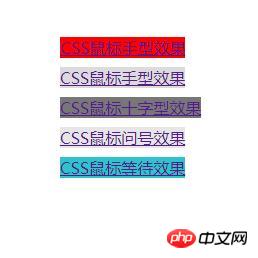 Web Front-end
Web Front-end
 CSS Tutorial
CSS Tutorial
 How to change the mouse cursor shape with CSS? (Example demonstration)
How to change the mouse cursor shape with CSS? (Example demonstration)
How to change the mouse cursor shape with CSS? (Example demonstration)
I believe that when you browse major websites, you will have different experiences through different mouse styles. This article will show you how to change the shape of the mouse through CSS? css cursor attribute has certain reference value. Friends in need can refer to it. I hope it will be helpful to you.
Effect Display

The cursor attribute specifies the type (shape) of the cursor to be displayed. This property defines the cursor shape used when the mouse pointer is placed within the bounds of an element. All major browsers support the cursor attribute.
Below we will give you a detailed introduction one by one through the specific css cursor example code of the mouse cursor shape change:
html code: define container
<div class="content"> <div class="box box1"><a href="">CSS鼠标手型效果</a></div> <div class="box box2"><a href="">CSS鼠标手型效果</a></div> <div class="box box3"><a href="">CSS鼠标十字型效果</a></div> <div class="box box4"><a href="">CSS鼠标问号效果</a></div> <div class="box box5"><a href="">CSS鼠标等待效果</a></div> </div>
cursor The hand attribute allows the mouse to display the hand effect
.box1 a{
background-color: red;
cursor:hand;
}The pointer attribute of cursor also allows the mouse to display the hand effect, but it is compatible with multiple browsers. This is recommended
.box2 a{
background-color: #DBDBDB;
cursor:pointer;
}The crosshair attribute of cursor allows the mouse to display a cross-shaped effect.
.box3 a{
background-color:#777777;
cursor:crosshair;
}The help attribute of cursor allows the mouse to display a question mark effect.
.box4 a{
background-color:#E6E6E6;
cursor:help;
}The wait attribute of cursor allows the mouse to display a waiting effect. This is a A loading effect
background-color:#2DC4CB; cursor:wait; }
cursor In addition to the above mouse cursor shape effects, there are also cursor effects that indicate different arrow directions: e-resize (arrow to the right), ne-resize (arrow to the right), n -resize (up arrow), nw-resize (up left arrow), w-resize (left arrow), sw-resize (down left arrow), s-resize (down arrow), se-resize (arrow pointing down to the right).
##
The above is the detailed content of How to change the mouse cursor shape with CSS? (Example demonstration). For more information, please follow other related articles on the PHP Chinese website!

Hot AI Tools

Undresser.AI Undress
AI-powered app for creating realistic nude photos

AI Clothes Remover
Online AI tool for removing clothes from photos.

Undress AI Tool
Undress images for free

Clothoff.io
AI clothes remover

Video Face Swap
Swap faces in any video effortlessly with our completely free AI face swap tool!

Hot Article

Hot Tools

Notepad++7.3.1
Easy-to-use and free code editor

SublimeText3 Chinese version
Chinese version, very easy to use

Zend Studio 13.0.1
Powerful PHP integrated development environment

Dreamweaver CS6
Visual web development tools

SublimeText3 Mac version
God-level code editing software (SublimeText3)

Hot Topics
 1386
1386
 52
52
 Building an Ethereum app using Redwood.js and Fauna
Mar 28, 2025 am 09:18 AM
Building an Ethereum app using Redwood.js and Fauna
Mar 28, 2025 am 09:18 AM
With the recent climb of Bitcoin’s price over 20k $USD, and to it recently breaking 30k, I thought it’s worth taking a deep dive back into creating Ethereum
 Vue 3
Apr 02, 2025 pm 06:32 PM
Vue 3
Apr 02, 2025 pm 06:32 PM
It's out! Congrats to the Vue team for getting it done, I know it was a massive effort and a long time coming. All new docs, as well.
 Can you get valid CSS property values from the browser?
Apr 02, 2025 pm 06:17 PM
Can you get valid CSS property values from the browser?
Apr 02, 2025 pm 06:17 PM
I had someone write in with this very legit question. Lea just blogged about how you can get valid CSS properties themselves from the browser. That's like this.
 A bit on ci/cd
Apr 02, 2025 pm 06:21 PM
A bit on ci/cd
Apr 02, 2025 pm 06:21 PM
I'd say "website" fits better than "mobile app" but I like this framing from Max Lynch:
 Stacked Cards with Sticky Positioning and a Dash of Sass
Apr 03, 2025 am 10:30 AM
Stacked Cards with Sticky Positioning and a Dash of Sass
Apr 03, 2025 am 10:30 AM
The other day, I spotted this particularly lovely bit from Corey Ginnivan’s website where a collection of cards stack on top of one another as you scroll.
 Using Markdown and Localization in the WordPress Block Editor
Apr 02, 2025 am 04:27 AM
Using Markdown and Localization in the WordPress Block Editor
Apr 02, 2025 am 04:27 AM
If we need to show documentation to the user directly in the WordPress editor, what is the best way to do it?
 Comparing Browsers for Responsive Design
Apr 02, 2025 pm 06:25 PM
Comparing Browsers for Responsive Design
Apr 02, 2025 pm 06:25 PM
There are a number of these desktop apps where the goal is showing your site at different dimensions all at the same time. So you can, for example, be writing
 Let's use (X, X, X, X) for talking about specificity
Mar 24, 2025 am 10:37 AM
Let's use (X, X, X, X) for talking about specificity
Mar 24, 2025 am 10:37 AM
I was just chatting with Eric Meyer the other day and I remembered an Eric Meyer story from my formative years. I wrote a blog post about CSS specificity, and



